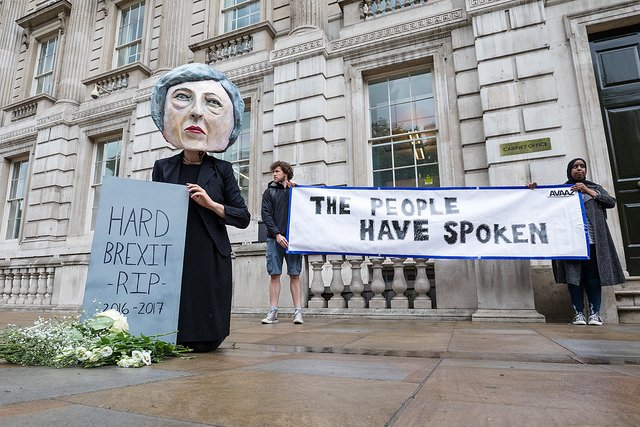North of Hadrian’s Wall, the party of Scottish nationalism has won an almost total victory. The Liberal Democrats and Labour have suffered huge losses, while the Conservatives maintained the one blue patch left. The Scottish National Party lowered the voting age to 16 and tapped into a reservoir of disenchantment with status quo politics. The referendum on Scottish independence may not have secured secession, but it did serve to strengthen the nationalist base. It was probably the sight of Tories and Labourites standing together, arm-in-arm, against the Scottish Left.
The Yes campaign got its revenge. The massacre of Labour MPs was something to behold on election night. The Labour heavy-weight Douglas Alexander was trounced by Mhairi Black, a 20 year-old SNP candidate, now the youngest MP in 350 years. The British conservative press was soon whining about the ‘invasion’ of SNP parliamentarians, while it accused the Left of ‘sour grapes’ in the midst of a Tory majority. It’s an encouraging sign that the forces of reaction feel threatened by the political realignment in Scotland, away from austerity lite to an anti-austerity position.
The success of the SNP demonstrates that there is a constituency for the anti-austerity case in the United Kingdom. Alex Salmond and Nicola Sturgeon combined progressive civic nationalism, Europeanism and the social democratic centre to win over the Labour base. This involved a pinch of left-wing populism, which we’ve seen score serious victories in Spain and Greece. However, the same nationalist impulse has not succeeded in Wales and Northern Ireland (due to different conditions). Meanwhile in England, there is no hope of left-wing nationalism taking hold.
The Death of Labour
You might think the SNP would scare Labour into compromise. Actually the opposite has happened, as the party lost its motherland to nationalists, it just retreated further. The new bromide is ‘aspiration’, which is nothing but a code-word for anti-poor class politics. The Labour leaders in waiting want to appeal to ‘aspirational voters’, which just means the Conservative middle-classes, the super-rich, and, of course, the commentariat and mainstream media. The party cannot comprehend its own decay, it can only continue along the same wretched path.
The Labour Party exhibited signs of total denial on the campaign trail, as Scotland was clearly undergoing an unprecedented realignment, and now the stage seems set for another right turn. Leading Blairite contender Andy Burnham, former Health Secretary, has attacked Unite leader Len McCluskey for calling on Labour to run left. He has also criticised New Labour and argued for an assessment of the Labour record on the economy and immigration. He now postures against the trade unions in a bid to satisfy the right-wing press.
It is quite something to witness a political party wilfully commit suicide. The new myth will be that Ed Miliband ran too far left, divided the party, split the vote, and handed the country to the Tories. This is a convenient fantasy for the Blairites to indulge in. Reality will confront from them once it becomes apparent that the 1997 victory was achieved under different conditions. It was only after 18 years of Thatcherism that the Labour Party appeared as a hopeful alternative. The Scots have rightly sought out an alternative. But where does this leave the English Left?

Why the Greens are not Enough
For the English Left, the Green Party looks like the only game in town. The Green movement has seen its membership rocket past mainstream parties, while its vote has exceeded 1 million. The hope is that the Green leadership will be able to transform this support into electoral gains over the next few years. But there is a flipside to this coin: The Green Party may well have failed to capitalise on the gains it has already made. It lost the Brighton council (which was probably deserved), but held onto the Brighton seat, while failing to win seats everywhere else. The vote was too diffuse to knock out establishment candidates. This fact could well lead to greater disillusionment.
Nevertheless, the example of the Greens shows tremendous potential. 50% of the Green vote was stolen from the Liberal Democrats, which constituted 26% of the Lib Dem vote. 19% of the Green vote was already behind them, while 18% of the Green vote was drawn from disaffection in the Labour base. It looks like Labour’s vote mostly stayed at home in this election. Yet surprisingly, 9% of Green voters were former Tories. It is a good sign that the Green movement chiselled into the base of major parties. These results both demonstrate progress, but also limitations.
Stealing votes of the official centre-ground can undermine the consensus. And there is a history of competition between the Green movement and the Liberal Democrats. In fact, the Green Party was named out of fear that the Liberals might have formed their own Green Party. This is not surprising as the two forces had the same class base: the metropolitan liberal middle-class. Of course, this picture is now changing, but there is a risk of the Green Party serving as a protest vote for former Lib Dems. So this may not take the Greens further in the long-run.
Against Defeatism
Right now, the English Left remains deeply fragmented. The Socialist Workers’ Party, once a leading heterodox Trotskyist organisation, has imploded over its appalling handling of rape allegations against Martin Smith, a prominent member of its central committee. Many of its sectaries can now be found scattered across a variety of organisations, such as RS21 and the IS network. This has only further entangled the Trot splinter cells, while the anarchists – in spite of the inspiration of Occupy – and the communist groups remain insignificant.
At the same time, there are ongoing attempts to build coalitions of the broad Left, such as the Trade Unionist and Socialist Coalition. Counterfire has been working to try and establish the People’s Assembly as a united front. Likewise, Left Unity is trying to bring together disparate progressive forces, from anarchists to social democrats, into a coherent party. None of these attempts are anything new, but they may pose hope for the Left to coalesce in years to come. But until then it looks as though the radicals are running on empty too.
It’s not enough to just march. The success of Syriza and Podemos comes down to organisation. The populist strategy encompasses, not just grass-roots mobilisation, but top-level coordination. Syriza backs solidarity networks, which provide basic services, as well as support to activists and striking workers. Meanwhile Podemos rallies groups in small communities against ‘the caste’. These efforts constitute the basic infrastructure of strong populist formations. It may be the only means to bulldoze through the edifice of austerity.
Photographs courtesy of id iom, and The Weekly Bull. Published under a Creative Commons license.





